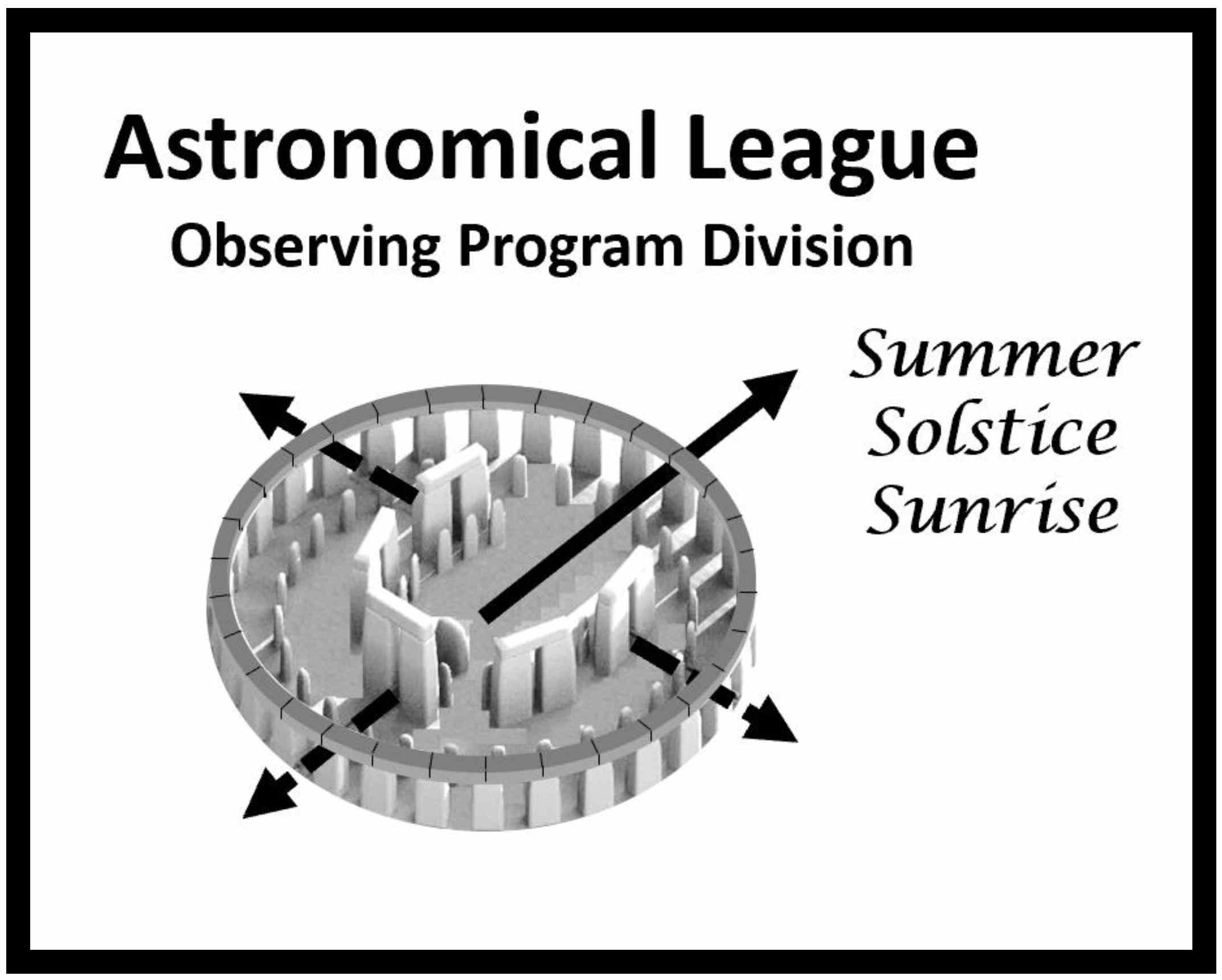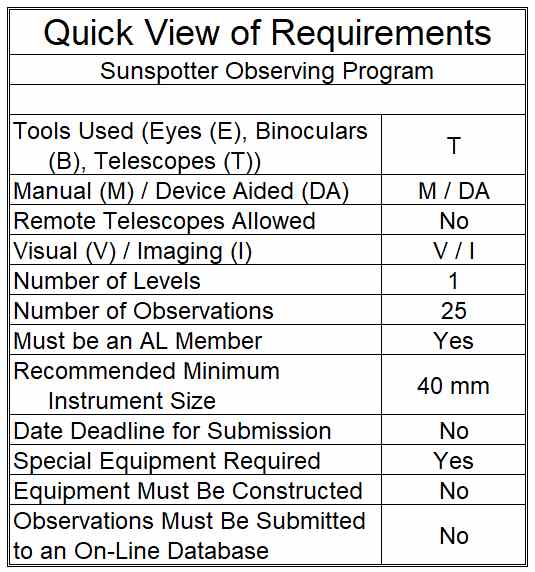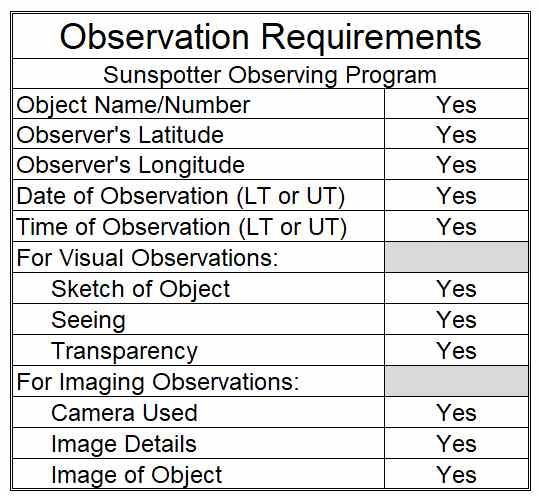Sunspotter Observing Program Coordinator:Scott Kranz |
 |
Introduction
| The purpose of this Observing Program is to encourage solar observing with an eye toward educating the amateur astronomer on solar features and their evolution. By following this regimen the observer will learn the various features of solar activity, learn how these change during their passage across the disk, and learn how to develop a regular observing program.
*** WARNING *** Before you start any solar observing program, make absolutely certain that you have safe filters and a safe set-up. Only use filters from reputable sources, and never use a “solar filter” that screws into an eyepiece. As Richard Hill states in “>Observe and Understand the Sun: “Observing the sun is the only inherently dangerous observing an amateur astronomer can do. Be aware of this at all times and take all necessary precautions. If you do not know a filter or procedure is safe then do not use it! Always err on the side of safety. An eye once damaged is forever damaged. Filters that let too much INFRARED light through can burn an eye if used visually. There is NO PAIN when this happens. Burned retinas can not be repaired. Excessive ULTRAVIOLET light has been shown to cause cataracts. So be very careful.” For more information on ways to safely observe the sun, click here. |
 |
Requirements and Rules
This certification is available to members of the Astronomical League, either through their local astronomical society or as members at large. If you are not a member and would like to become one, check with your local astronomical society, search for a local society on the Astronomical League Website (click here), or join as a Member-at-Large (click here).
|
Before starting this Observing Program, please review Information Required to Complete the Sunspotter Program. This will help answer any question you may have.
The Sunspotter Observing Program may be done visually with drawings or with images. The requirements for completion are the same. All observing must be done through a white-light filter. In the Sunspotter Observing Program, you will make two sets of drawings or take two sets of images. The first set is five detailed sketches or images of sunspot groups. The second set is 20 or more sketches or images of the whole solar disk during two solar rotations (one rotation is about 30 days). Artistic skill is not a requirement! Just diagram what you see as well as your skills allow. Use a number 2A lead pencil for best results when drawing. |
 |
In the second set of drawings or images, you will sketch the whole disk of the sun throughout the passage of large sunspot groups during two different solar rotations. On the Solar Disk Drawing Form, outline the sunspot penumbrae and shade in the umbrae on the large circle. Classify all the sunspot groups on the disk and show the McIntosh classification letters on the small circle. Do a sunspot count, compute the Wolf Number, and fill out all the other blanks on the form. One of your sketches or drawings (in either the first or second set of drawings) should show the “Wilson effect”. We realize that weather conditions may prevent daily observing, but at least half of the days for any given rotation should be observable. You should have a minimum of 20 whole disk drawings or images for the two rotations. To get an idea of how to fill out this drawing form, see an example here.
This program is designed to be completed using a white light solar filter. There is also a Solar Observing Program for observations made using an H-Alpha Telescope: https://www.astroleague.org/hydrogen-alpha-solar-observing-program
Please Note: Since the purpose of this Observing Program is to understand the Sun and learn how to observe solar features, at least 15 of your 20 full disk drawings or images must contain actual sunspots. During solar minimum, there may be days, or weeks, without any solar activity. If you are in the process of working on the Sunspotter Observing Program during this minimum time, you need to wait till the Sun once again becomes active. Without actually having sunspots for a great majority of the days there cannot be any real learning or understanding of the Sun and that is the purpose of doing this observing program.
Observations must include:
- The Objective Name
- Date and Time (local time or UT)
- Latitude and Longitude of the observations
- A description
- The equipment used.
To qualify for the League’s Sunspotter Observing Program, you must be a member of the Astronomical League, either as a member of a club affiliated with the League or as a Member at Large.
Submitting for Certification
Although a member can earn a certificate for doing the observations visually as well as a certificate for doing the observations through imaging, only one pin will be awarded, and the same number will be used. Those completed using imaging will have an “i” appended to the number.
| When your observations and drawings or images are completed, have them reviewed and approved by an officer of your astronomy society, or a qualified, experienced second party if you do not belong to a society. Have this person send a letter or email verifying your work. Send this note and copies of the observations to the Sunspotter Observing Program Coordinator. Images may be placed on a website for review. The Sunspotter Observing Program certificate and pin will be forwarded to your club officer for formal presentation, and your name will appear in the Reflector. Members at Large should send copies of their observations directly to the Sunspotter Observing Program Coordinator. |  |
Be sure to include your name, mailing address, email address, phone number, society affiliation, and to whom the certification should be sent.
Enjoy your daytime observing!
Sunspotter Observing Program Coordinator:Scott Kranz |
Upon verification of your submission and of your active membership in the Astronomical League, your recognition (certificate, pin, etc.) will be sent to you or to the awards coordinator for your society, as you specified. Your name will also appear in an upcoming issue of the Reflector magazine and in the Astronomical League’s online database. Congratulations. Good luck with your next observing challenge.
Notes:
Terms and Definitions You May Need to Know:
- Faculae: relatively large (greater than an arc minute) irregularly shaped light area; sometimes serpentine in shape. Sunspots are usually located in Facula.
- Granulation: fine grain structure of the solar photosphere. Grains appear to be one to two arc-seconds in diameter.
- Light bridge: a bright ribbon or band that may appear to connect two sunspots.
- Limb darkening: the effect of perspective where the edge of the solar disk appears darker than the center because it is a sphere.
- >McIntosh Sunspot Classification System: Adds classes for the type of the largest sunspot and sunspot distribution to the Modified Zurich Class. Pages 7-11 of the Observe the Sun has a good discussion and figures to help you classify groups by this three-letter system. (For example, a small lone sunspot with a penumbra might be coded as Hsx. A very large complex group might be Fkc.)
- <Modified Zurich Sunspot Class: A seven class (A-F, H) system of describing a sunspot group. The size of the group and distribution of penumbrae, if any, are factors.
- Penumbra: a gray area which frequently, but not always, appears around an individual sunspot or group of sunspots.
- Penumbral fibril: fiber like lines that may appear to radiate out from an umbra into the surrounding penumbra.
- Penumbral fragment: a penumbra without a sunspot.
- Penumbral grain: granular or small patchy structure that may be visible in the penumbra.
- Pores: tiny, less than one arc-second, dark areas which are not as dark as a sunspot.
- Solar north: Solar north is not the same as terrestrial north. During the course of an earth year, the sun’s axis tilts over 26 degrees east and west of the earth’s axis, and about 7 degrees toward and away from earth. These variations are due to a combination of the axial tilts of the Earth and Sun. Diagrams such as those on pages 13 and 14 of the Observe the Sun manual will help you estimate Solar north for the day of your observation.
- Solar rotation: the sun does not rotate as a solid body. The equator rotates in about 25 days, the polar area in about 30 days. Use about 28 days for a solar rotation at typical sunspot latitudes.
- Sunspot Group: A group may be anything from a single isolated sunspot to a complex elongated cluster of spots.
- Umbra: The dark black area of a Sunspot.
- Wilson effect: This effect of perspective is seen when a sunspot is near the solar limb. The umbra appears displaced within the penumbra, usually toward the center of the sun.
- Wolf Sunspot number (R): a traditional method of counting sunspots. Count the individual sunspots. Count the number of groups. (An individual sunspot can count as a group if it is sufficiently separated from other spots or groups.) The Wolf number is ten times the number of sunspot groups plus the number of spots.
About the September, 1997 revision:
The revised Sunspotter Observing Program award requirements consolidated the former two-part program into one program and one certificate. The sketching or imaging, and the required information have been simplified, some definitions have been added, and new sample forms have been provided.
Links:
- How to Safely Observe the Sun
- The Sunspotter Observing Program Sunspot Drawing Form
- The Sunspotter Observing Program Sunspot Example Form
- The Sunspotter Observing Program Solar Disk Drawing Form
- The Sunspotter Observing Program Solar Disk Example Form
- Information Required to Complete the Sunspotter Observing Program
- Find Your Observing Program Award



